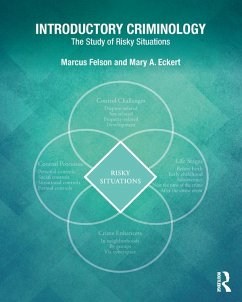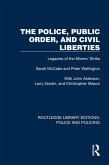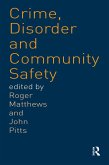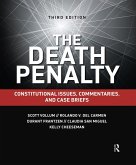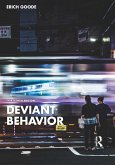71,95 €
71,95 €
inkl. MwSt.
Sofort per Download lieferbar

36 °P sammeln
71,95 €
Als Download kaufen

71,95 €
inkl. MwSt.
Sofort per Download lieferbar

36 °P sammeln
Jetzt verschenken
Alle Infos zum eBook verschenken
71,95 €
inkl. MwSt.
Sofort per Download lieferbar
Alle Infos zum eBook verschenken

36 °P sammeln
- Format: PDF
- Merkliste
- Auf die Merkliste
- Bewerten Bewerten
- Teilen
- Produkt teilen
- Produkterinnerung
- Produkterinnerung

Bitte loggen Sie sich zunächst in Ihr Kundenkonto ein oder registrieren Sie sich bei
bücher.de, um das eBook-Abo tolino select nutzen zu können.
Hier können Sie sich einloggen
Hier können Sie sich einloggen
Sie sind bereits eingeloggt. Klicken Sie auf 2. tolino select Abo, um fortzufahren.

Bitte loggen Sie sich zunächst in Ihr Kundenkonto ein oder registrieren Sie sich bei bücher.de, um das eBook-Abo tolino select nutzen zu können.
Introductory Criminology: The Study of Risky Situations presents, in short, readable chapters, a narration encompassing diverse situations in which crime is likely to occur, and explores the likely causes of and societal responses to criminal events.
- Geräte: PC
- mit Kopierschutz
- eBook Hilfe
- Größe: 6.23MB
Andere Kunden interessierten sich auch für
![Policing a Perplexed Society (eBook, PDF) Policing a Perplexed Society (eBook, PDF)]() Robert MarkPolicing a Perplexed Society (eBook, PDF)52,95 €
Robert MarkPolicing a Perplexed Society (eBook, PDF)52,95 €![Hegemonic Individualism and Subversive Stories in Capital Mitigation (eBook, PDF) Hegemonic Individualism and Subversive Stories in Capital Mitigation (eBook, PDF)]() Ross KleinstuberHegemonic Individualism and Subversive Stories in Capital Mitigation (eBook, PDF)42,95 €
Ross KleinstuberHegemonic Individualism and Subversive Stories in Capital Mitigation (eBook, PDF)42,95 €![Criminal Enterprise (eBook, PDF) Criminal Enterprise (eBook, PDF)]() Christopher HardingCriminal Enterprise (eBook, PDF)46,95 €
Christopher HardingCriminal Enterprise (eBook, PDF)46,95 €![The Police, Public Order, and Civil Liberties (eBook, PDF) The Police, Public Order, and Civil Liberties (eBook, PDF)]() Sarah McCabeThe Police, Public Order, and Civil Liberties (eBook, PDF)28,95 €
Sarah McCabeThe Police, Public Order, and Civil Liberties (eBook, PDF)28,95 €![Crime, Disorder and Community Safety (eBook, PDF) Crime, Disorder and Community Safety (eBook, PDF)]() Roger MatthewsCrime, Disorder and Community Safety (eBook, PDF)58,95 €
Roger MatthewsCrime, Disorder and Community Safety (eBook, PDF)58,95 €![The Death Penalty (eBook, PDF) The Death Penalty (eBook, PDF)]() Scott VollumThe Death Penalty (eBook, PDF)61,95 €
Scott VollumThe Death Penalty (eBook, PDF)61,95 €![Deviant Behavior (eBook, PDF) Deviant Behavior (eBook, PDF)]() Erich GoodeDeviant Behavior (eBook, PDF)75,95 €
Erich GoodeDeviant Behavior (eBook, PDF)75,95 €-
-
-
Introductory Criminology: The Study of Risky Situations presents, in short, readable chapters, a narration encompassing diverse situations in which crime is likely to occur, and explores the likely causes of and societal responses to criminal events.
Dieser Download kann aus rechtlichen Gründen nur mit Rechnungsadresse in A, B, BG, CY, CZ, D, DK, EW, E, FIN, F, GR, HR, H, IRL, I, LT, L, LR, M, NL, PL, P, R, S, SLO, SK ausgeliefert werden.
Produktdetails
- Produktdetails
- Verlag: Taylor & Francis eBooks
- Seitenzahl: 480
- Erscheinungstermin: 4. Dezember 2017
- Englisch
- ISBN-13: 9781317211839
- Artikelnr.: 50417466
- Verlag: Taylor & Francis eBooks
- Seitenzahl: 480
- Erscheinungstermin: 4. Dezember 2017
- Englisch
- ISBN-13: 9781317211839
- Artikelnr.: 50417466
- Herstellerkennzeichnung Die Herstellerinformationen sind derzeit nicht verfügbar.
Marcus Felson is the originator of the routine activity approach and author of Crime and Everyday Life. He has also authored Crime and Nature, and he serves as a professor at Texas State University in San Marcos, Texas. He has a B.A. from the University of Chicago and an M.A. and Ph.D. from the University of Michigan. He has received the 2014 Honoris Causa from the Universidad Miguel Hernandez in Spain, and he has been given the Ronald Clarke Award by the Environmental Criminology and Crime Analysis group and the Paul Tappan Award by the Western Society of Criminology. He has been a guest lecturer in Argentina, Australia, Belgium, Brazil, Canada, Chile, China, Denmark, El Salvador, England, Finland, France, Germany, Hong Kong, Hungary, Italy, Japan, Mexico, the Netherlands, New Zealand, Norway, Poland, Scotland, South Africa, Spain, Sweden, and Switzerland. He has applied routine activity thinking to many topics, including theft, violence, sexual abuse, white-collar crime, and corruption. Two books honoring Professor Felson's work have been published, one in English and another in Spanish.
Mary A. Eckert has devoted an active career to applied research in criminal justice and program evaluation. She has an M.A. and Ph.D. from New York University. Her B.A. is from the College of New Rochelle. Dr. Eckert served as Research Director of the New York City Criminal Justice Agency, Inc., where she authored many research reports and guided that agency's diverse research agenda, including work on pretrial risk assessment, court case processing, and evaluation of alternative-to-incarceration programs. She then served in the New Jersey Office of the Attorney General, with a special focus on statistical evaluation of vehicle stops to assist the New Jersey State Police in reducing the potential for racial profiling. Her work has been recognized by the New York Association of Pretrial Service Agencies and the State of New Jersey. She has also served as an adjunct professor at New York University, Montclair State University, and Texas State University. Marcus Felson's wife and life partner, this book is her second collaboration with her husband.
Mary A. Eckert has devoted an active career to applied research in criminal justice and program evaluation. She has an M.A. and Ph.D. from New York University. Her B.A. is from the College of New Rochelle. Dr. Eckert served as Research Director of the New York City Criminal Justice Agency, Inc., where she authored many research reports and guided that agency's diverse research agenda, including work on pretrial risk assessment, court case processing, and evaluation of alternative-to-incarceration programs. She then served in the New Jersey Office of the Attorney General, with a special focus on statistical evaluation of vehicle stops to assist the New Jersey State Police in reducing the potential for racial profiling. Her work has been recognized by the New York Association of Pretrial Service Agencies and the State of New Jersey. She has also served as an adjunct professor at New York University, Montclair State University, and Texas State University. Marcus Felson's wife and life partner, this book is her second collaboration with her husband.
Getting Started. Part 1. The Crime Challenge. Unit 1.1 The Need to Control
Disputes. Unit 1.2. Containing Sexual Temptations. Unit 1.3 Protecting
Property. Unit 1.4 Safeguarding Children. Perspective on Part 1. Part 2.
Four Types of Crime Control. Unit 2.1 Personal Controls. Unit 2.2 Social
Controls. Unit 2.3 Situational Controls. Unit 2.4 Formal Controls.
Perspective on Part 2. Part 3. Realistic Justice. Unit 3.l Assigning
Responsibility. Unit 3.2 Realistic Policing. Unit 3.3 Realistic Court
Activity. Unit 3.4 Realistic Sanctions. Unit 3.5 Efforts and Realities.
Unit 3.6 Practical Crime Data. Perspective on Part 3. Part 4. Risky Ages.
Unit 4.1 The Teenage Brain Unit 4.2 Teenage Volatility. Unit 4.3 Peer
Influences. Unit 4.4 Situational Inducements. Unit 4.5 Time with Peers.
Perspective on Part 4. Part 5. Overt Crime Areas. Unit 5.1 Tough
Neighborhoods. Unit 5.2 Cohesion vs. Intimidation. Unit 5.3 Exclusion. Unit
5.4 Concentration. Unit 5.5 Accommodation. Unit 5.6 The Pathway to Decay.
Unit 5.7 Mapping Crime. Perspective on Part 5. Part 6. Risky Settings for
Women. Unit 6.1 The Policy Challenge. Unit 6.2 Risky Streets. Unit 6.3
Risky Homes. Unit 6.4 Risky Nights. Perspective on Part 6. Part 7. Crime
Enhancers. Unit 7.1 Crime in Groups. Unit 7.2 Crime via Cyberspace.
Perspective on Part 7. Wrapping Up. Index.
Disputes. Unit 1.2. Containing Sexual Temptations. Unit 1.3 Protecting
Property. Unit 1.4 Safeguarding Children. Perspective on Part 1. Part 2.
Four Types of Crime Control. Unit 2.1 Personal Controls. Unit 2.2 Social
Controls. Unit 2.3 Situational Controls. Unit 2.4 Formal Controls.
Perspective on Part 2. Part 3. Realistic Justice. Unit 3.l Assigning
Responsibility. Unit 3.2 Realistic Policing. Unit 3.3 Realistic Court
Activity. Unit 3.4 Realistic Sanctions. Unit 3.5 Efforts and Realities.
Unit 3.6 Practical Crime Data. Perspective on Part 3. Part 4. Risky Ages.
Unit 4.1 The Teenage Brain Unit 4.2 Teenage Volatility. Unit 4.3 Peer
Influences. Unit 4.4 Situational Inducements. Unit 4.5 Time with Peers.
Perspective on Part 4. Part 5. Overt Crime Areas. Unit 5.1 Tough
Neighborhoods. Unit 5.2 Cohesion vs. Intimidation. Unit 5.3 Exclusion. Unit
5.4 Concentration. Unit 5.5 Accommodation. Unit 5.6 The Pathway to Decay.
Unit 5.7 Mapping Crime. Perspective on Part 5. Part 6. Risky Settings for
Women. Unit 6.1 The Policy Challenge. Unit 6.2 Risky Streets. Unit 6.3
Risky Homes. Unit 6.4 Risky Nights. Perspective on Part 6. Part 7. Crime
Enhancers. Unit 7.1 Crime in Groups. Unit 7.2 Crime via Cyberspace.
Perspective on Part 7. Wrapping Up. Index.
Getting Started. Part 1. The Crime Challenge. Unit 1.1 The Need to Control
Disputes. Unit 1.2. Containing Sexual Temptations. Unit 1.3 Protecting
Property. Unit 1.4 Safeguarding Children. Perspective on Part 1. Part 2.
Four Types of Crime Control. Unit 2.1 Personal Controls. Unit 2.2 Social
Controls. Unit 2.3 Situational Controls. Unit 2.4 Formal Controls.
Perspective on Part 2. Part 3. Realistic Justice. Unit 3.l Assigning
Responsibility. Unit 3.2 Realistic Policing. Unit 3.3 Realistic Court
Activity. Unit 3.4 Realistic Sanctions. Unit 3.5 Efforts and Realities.
Unit 3.6 Practical Crime Data. Perspective on Part 3. Part 4. Risky Ages.
Unit 4.1 The Teenage Brain Unit 4.2 Teenage Volatility. Unit 4.3 Peer
Influences. Unit 4.4 Situational Inducements. Unit 4.5 Time with Peers.
Perspective on Part 4. Part 5. Overt Crime Areas. Unit 5.1 Tough
Neighborhoods. Unit 5.2 Cohesion vs. Intimidation. Unit 5.3 Exclusion. Unit
5.4 Concentration. Unit 5.5 Accommodation. Unit 5.6 The Pathway to Decay.
Unit 5.7 Mapping Crime. Perspective on Part 5. Part 6. Risky Settings for
Women. Unit 6.1 The Policy Challenge. Unit 6.2 Risky Streets. Unit 6.3
Risky Homes. Unit 6.4 Risky Nights. Perspective on Part 6. Part 7. Crime
Enhancers. Unit 7.1 Crime in Groups. Unit 7.2 Crime via Cyberspace.
Perspective on Part 7. Wrapping Up. Index.
Disputes. Unit 1.2. Containing Sexual Temptations. Unit 1.3 Protecting
Property. Unit 1.4 Safeguarding Children. Perspective on Part 1. Part 2.
Four Types of Crime Control. Unit 2.1 Personal Controls. Unit 2.2 Social
Controls. Unit 2.3 Situational Controls. Unit 2.4 Formal Controls.
Perspective on Part 2. Part 3. Realistic Justice. Unit 3.l Assigning
Responsibility. Unit 3.2 Realistic Policing. Unit 3.3 Realistic Court
Activity. Unit 3.4 Realistic Sanctions. Unit 3.5 Efforts and Realities.
Unit 3.6 Practical Crime Data. Perspective on Part 3. Part 4. Risky Ages.
Unit 4.1 The Teenage Brain Unit 4.2 Teenage Volatility. Unit 4.3 Peer
Influences. Unit 4.4 Situational Inducements. Unit 4.5 Time with Peers.
Perspective on Part 4. Part 5. Overt Crime Areas. Unit 5.1 Tough
Neighborhoods. Unit 5.2 Cohesion vs. Intimidation. Unit 5.3 Exclusion. Unit
5.4 Concentration. Unit 5.5 Accommodation. Unit 5.6 The Pathway to Decay.
Unit 5.7 Mapping Crime. Perspective on Part 5. Part 6. Risky Settings for
Women. Unit 6.1 The Policy Challenge. Unit 6.2 Risky Streets. Unit 6.3
Risky Homes. Unit 6.4 Risky Nights. Perspective on Part 6. Part 7. Crime
Enhancers. Unit 7.1 Crime in Groups. Unit 7.2 Crime via Cyberspace.
Perspective on Part 7. Wrapping Up. Index.
